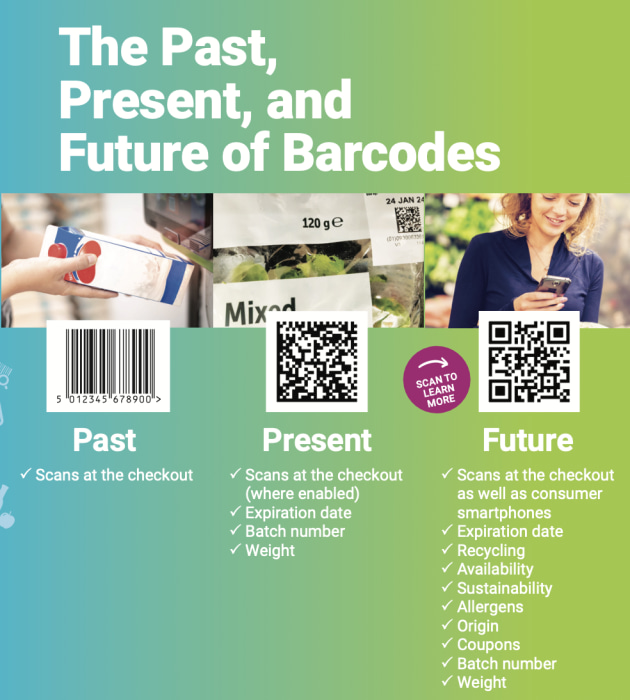The evolution of barcoding has seen significant advancements since the first traditional linear barcode was launched 50 years ago. Matthews Australasia provides an update on next generation 2D barcoding, its benefits and implementation.
At the end of 2020, the international not-for-profit and only authorised provider of authentic and unique barcodes, GS1, launched a global initiative to transition from traditional to next generation barcodes.
In Australia, Matthews Australasia has been an integral collaborator with key retailers as they prepare to deploy 2D barcodes.
Matthews Australasia sales product specialist – iDSnet & LPA, Braydon Cocks, says, “As technology has continued to progress, 2D barcodes have emerged, offering a more compact and information-dense alternative.
“Size wise, for instance, if you put them side by side, a 2D code is less than half the size of the linear EAN-13 barcode, which is widely used today.
“Advancements in the past couple of years have seen Woolworths spearhead the adoption of 2D barcodes, and the retailer is now urging its suppliers to transition to this innovative system.”
Cocks suggests that while Woolworths is the only major supermarket in Australia to be using 2D barcoding, its substantial benefits could set a new industry standard.

Benefits of 2D
One of the main advantages of 2D barcodes is facilitating traceability. Unlike traditional barcodes, 2D barcodes can store a significant amount of information in a small space with the most beneficial being the best before or batch, which is crucial for tracking a product’s journey from production to the consumer.
“This improved traceability is vital for ensuring food safety, managing recalls efficiently and providing consumers with detailed product information.
“Essentially, it stops consumers from purchasing expired food, or as a minimum gives them a warning at the checkout, if it is near expiry,” he says.
2D barcodes also offer significant time savings.
“The ability to encode more information, means fewer scans are required to obtain all necessary product details, streamlining the checkout process and inventory management.
“By embedding data into the barcode you remove the need for supermarket staff to read the best before or batch information, they now just scan it.
“This efficiency can lead to less errors, reduced risk of expired products going home and reduced wait times for customers, enhancing the overall shopping experience,” he says.
Rollout plans
Cocks says Woolworths adopted a phased approach to implement 2D barcoding, starting with the DataMatrix and ultimately adopting the GS1 digital link embedded QR code.
The rollout began with red meat and chicken, then other meats, deli items, quick-sale products and pre-packaged salads because barcodes related to variable weights and date codes are more straightforward to change.
Inline printing capability
For manufacturers to shift to 2D codes, the capability to print inline is key.
“It means they need to have the necessary equipment to print barcodes directly onto packaging during the production process – for instance, we’ve supplied many Linx TT5 and TT10 coders into plants on the bagging machine.
“Thermal Transfer Overprinting (TTO) technology is designed to code onto flexible film packaging, labels, generic flow-wrap packaging and other substrates used in fresh produce and meat goods. Because a lot of salad bags for instance, use this type of technology to print on bags, all the manufacturer has to do is add a 2D barcode and they’re there,” Cocks says.
There are also space-saving benefits with 2D barcodes.
“Despite being smaller than standard EAN-13 barcodes, 2D barcodes can hold much more information, and this space efficiency is beneficial for packaging design, allowing more room for branding and other essential information.”
Looking ahead
Cocks says the future of 2D barcoding includes plans to eventually transition from DataMatirx to QR codes, offering greater flexibility and information-storage capabilities. An added benefit is the inline printers used for DataMatrix also print QR codes, alleviating any potential concerns about additional equipment changes.
“Woolworths’ move towards 2D barcoding marks a significant step forward in the food industry. The benefits of enhanced traceability, time savings, and space efficiency make the format an attractive option for suppliers.
With more suppliers investigating inline coding solutions, those with a package code management solution, such as iDSnet, transition smoothly, but there are suppliers that are unsure how to take the first step.
“They naturally have a lot of questions from how to create the codes, what technologies to use, how to transition their business to 2D barcodes and how to ensure those codes meet specs and scan properly.
“This is where many manufacturers have told us that our Barcode Learning Centre and 2D Barcode Learning Centre have been a great support and resource.
“They’re free industry resources that we created from over four decades of experience in product coding, labelling and automatic data capture, starting with the basics right through to specifics by industry sector,” he says.
At APPEX this year, Matthews launched its Barcode Academy, designed to augment its existing resources and help those in the industry solidify their understanding of supply-chain standards, and help prevent issues such as recalls, withdrawals, and delays in DCs.
With these free tools, Matthews is committed to helping businesses adopt 2D coding and the benefits it offers.






